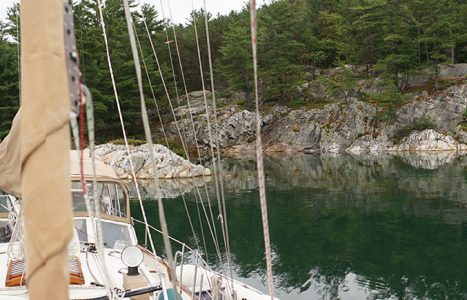Today I’ve been charged with writing about Bay Rum. As many of you know, rum is a favorite spirit of mine thanks to numerous sailing trips in the Caribbean. Rum was invented there and is nearly as plentiful as fresh water.
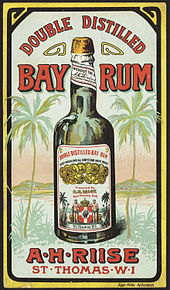
Imagine my disappointment when my research revealed that Bay Rum isn’t even anything you can drink! It’s a kind of cologne that is distilled like rum along with bayberries or maybe bay laurel or a tincture of Birch Bayh and some exotic West Indies herbs and spices and used – ah, what?
Wait a minute—Julie is flagging me, trying to tell me something about this blog. Oh!?! Well! Paint me red and call me a fire truck! Julie just clarified my topic. I’m not supposed to write about Fine Bay Rum. I’m supposed to write about Baie Fine—which has nothing to do with rum or the Caribbean. Now that makes a lot more sense since we were there recently and I’ve got plenty to say about it.
I didn’t really want to write about smelly old Bay Rum, anyway. I’d probably get off on some tangent about Baba Rum Raisin, the fictional adolescent perfect master in National Lampoon and whatever Doug Kinney–a founder of the magazine–wrote about Henry Kissinger’s hemorrhoids.
But Baie Fine—pronounced “bay finn”—is something I can stay focused on because it is an incredibly beautiful and wild part of the North Channel.
Julie and I cruised the short distance from Heywood Island to the mouth of Baie Fine on Saturday, Aug. 27. Immediately on entering the narrow channel into the bay we saw the Okeechobee Lodge, which is a prime piece of old northwoods resort property lovingly restored as a private retreat, according to locals. Besides several docks, numerous cabins and a bayside swimming pool, it even has its own helicopter pad! All nestled along the gently sloping shores at the mouth of Baie Fine. It is the only shoreline along the 9-mile long bay that can be described as “gently sloping.”
Both sides of the bay are an ever-changing montage of steep pine-lined hills, grey-pink granite escarpments and snow-white quartzite bluffs and peaks that comprise the Blue Ridge along the north side of the bay and the Killarney Ridge along the south. The ridges are extensions of the LaCloche Range and the Killarney National Park. Baie Fine may be a proper fjord—which are formed by retreating glaciers–but I could find no definitive science asserting that. If it is a fjord, it is one of very few fjords in North America outside of Alaska, and one of a very few fresh-water fjords in the world. Whatever it is, it is as beautiful as its sides are rugged.
We gingerly made our way up the bay sometimes mere yards from massive boulders and sheer granite cliffs to starboard.

The bay is narrow—no more than a mile across at one point and less than half that most of way. Much of it is also rather shallow and rife with islands, shoals, rocks, deadheads (sunken logs and trees, not grateful fans of Jerry Garcia and his band) and other nasties lurking underwater waiting to puncture a hull or take a bite from the keel of the boats of careless or unsuspecting boaters.
We motored a couple miles up the bay and ducked into Marianne Bay, a charming two-to-three acre microcosm of Baie Fine with pine trees marching up steep slopes on two-thirds of the round cove, a pair of low granite and quartzite outcrops anchoring the northeast shore. A rocky island separates Marianne (also known as Mary Ann Cove) from the main bay and affords protection from weather from any direction. The island, which has a cabin and docks at its northeast end, also defines the north side of a short, narrow channel that runs alongside the granite outcrop and opens into another, small but more open bay.
When we entered Marianne Bay, a houseboat and a couple of sailboats were parked along the southwest shore of the anchorage. A pair of motorboats were rafted up and tied to the southernmost escarpment. We wasted little time dropping anchor near the middle of the cove and backing up to the northern outcrop where I tied a line to a conveniently placed boulder.

We felt like we had the best seat in the house—the view from our cockpit was of those beautiful rock formations—both crowned with bonsai-like pines and shrubs. We liked the cove so much we stayed three days! I did some fishing and landed and released a fine Northern—known locally as pickerel.
One afternoon we dinghied over to the adjacent bay and located a trailhead that would lead us to the top of the tallest peak in the area, the nearly 1,100-foot tall Casson Peak. This amazing peak was known as Nehahupkung by the Iroquois who consider it sacred. It was dubbed Frazer (Bay) Hill by European interlopers, then officially designated Casson Peak in 1988 for A.J. Casson one of Canada’s famous Group of Seven scenic painters.
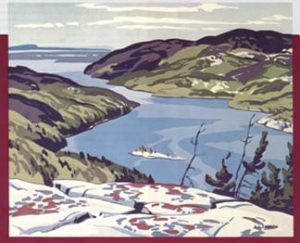
Casson, who joined the group after an original member quit, is said to have loved the North Channel and Killarney area. In 1947, Casson and a small party climbed the hill where he painted a view of the entrance to Baie Fine. This quartzite upthrust offers a commanding view of the channels and bays to the south and west. To the east and north a carpet of pine forests are interrupted with the fingers of the North Channel or pierced by other gleaming white quartzite peaks and the grey granite domes. The effect is breathtaking and worth the nearly hour-long hike and occasional rock scramble to reach the top.
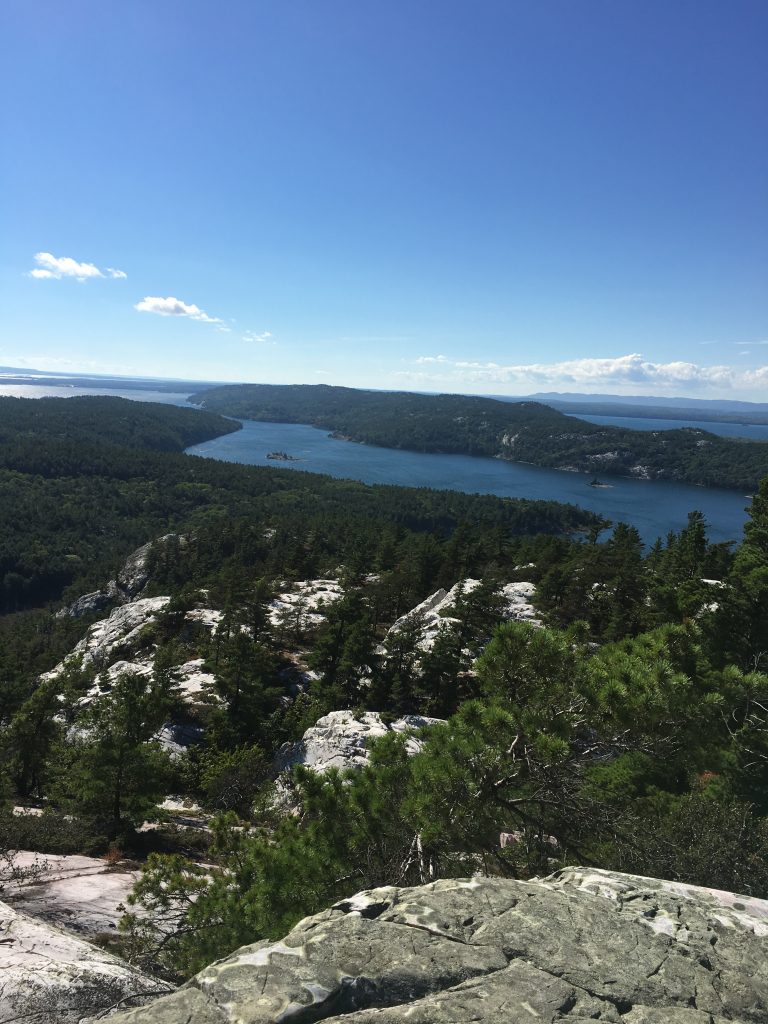
On Wednesday we weighed anchor in Marianne Bay and cruised all the way up Baie Fine to its end, an anchorage known as The Pool. The final mile or so before getting to The Pool requires diligent attention to obstacles and abruptly rising shoals through a very narrow channel. A couple cottages are perched on rocky islands near the entrance to the bay, but it is again mostly enclosed by steep forested slopes or rock cliffs. We parked near a bend in the bay, just off a 30-foot tall while wall defaced with graffiti. Some of the graffiti was artfully done, but it was graffiti, nonetheless, and a distraction in this otherwise pristine setting.
Once satisfied that our Mantus anchor was holding securely in the notoriously grassy bottom of The Pool, Julie and I piled into the dinghy and motored to the trailhead we spotted on our way in. The trail was to Lake Topaz, an isolated lake just north of the pool. Almost entirely encased in sheer white quartzite walls, Lake Topaz is known for its lustrous blue/green color.
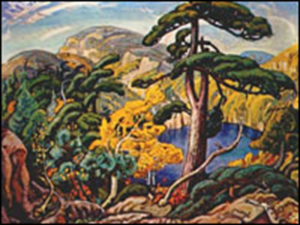
Its renown is such that it is thought to be the subject of a 1938 painting called “Bright Land” by another of Canada’s Group of Seven painters, Arthur Lismer. Lismer presumably actually visited the lake.
The afternoon sky was mostly cloudy with the sun peeking through on occasion, so we didn’t get the radiant gem-like colors described by other visitors, but it was still beautiful and work the fairly easy mile-long hike. The mountain forming the south shore of Topaz afforded us excellent views down into The Pool where we could see Gaviidae floating peacefully at anchor.
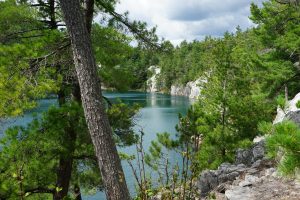
We left The Pool the next morning for Snug Harbour after I hooked another nice bass—this time from the foredeck of Gaviidae. Unfortunately, the bass spit the hook before I could get a net to it. I think I would’ve kept that one for dinner, sauteed in a butter rum sauce and a side of coconut-infused basmati rice. Probably served with one of Julie’s favorite and infamous “Rum Thingies”—that’s dark rum mixed with mango-heavy tropical juices, coconut milk and spritzed up with ginger beer. Ultimately, I don’t think I have any use for Bay Rum—fine or otherwise, but I’d definitely visit Baie Fine again.
August 27 – September 1, 2016 Baie Finn 46° 02.702’N 81° 28.728’W 890.4 Nautical Miles
##

